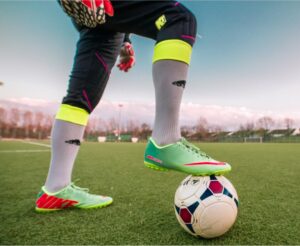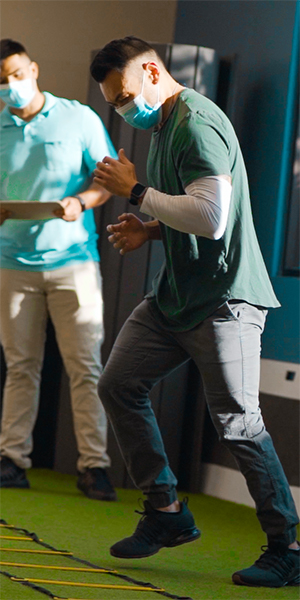Sports Physical Therapy
Athletes demand a lot from their bodies. Our physical therapists provide the expert care and guidance you need to enhance your performance, build resilience, and prevent injuries.



Don’t let a sports injury keep you on the sidelines. Whether you’re a professional athlete, a high school player, or a weekend warrior, our team at Optimal Therapy specializes in sports physical therapy to get you back in the game. We focus not only on treating your injury but also on helping you understand how it happened and how to prevent it from recurring.
Our approach to sports rehabilitation is a comprehensive blend of prevention, evaluation, and treatment for anyone with an active lifestyle. We use a variety of evidence-based techniques to restore your activity, strength, and motion after an injury.
Optimal Therapy offers a range of advanced treatment options to help you recover faster and perform at your best.
Blood Flow Restriction (BFR) Training: This innovative technique allows you to build strength and endurance at a lower intensity, which is ideal for early-stage recovery.
Dry Needling: A highly effective technique to reduce muscle tension and pain by targeting trigger points. It is often used for conditions like tendinitis, sciatica, and muscle strains.
Myofascial Release Techniques (including Cupping): Releasing muscular tension and improving blood flow can accelerate healing. We use modern techniques like Cupping, which is a popular method among elite athletes to help with recovery and pain relief.
Kinesio Taping (KT Taping): This rehabilitative tape provides support to muscles and joints, helping to decrease pain and inflammation while allowing for unrestricted movement.
Return to Sport Testing: Our specialized testing helps us determine if your body is truly ready to return to competition, significantly reducing the risk of re-injury.

Returning to your sport after an injury, especially a major one like an ACL tear, requires a strategic plan. Without proper assessment, you’re at high risk for re-injury.
Our Return to Sport program includes a battery of evidence-based tests to accurately assess your readiness. These tests can take up to 60 minutes and measure everything from muscle strength and endurance to movement efficiency and limb confidence.
What to Expect from Return to Sport Testing:
Hop Testing: To evaluate power and symmetry between your legs.
Y-Balance Testing: To assess balance and stability.
Quad Strength & Endurance Measurements: To ensure your muscles are strong enough for sport.
Movement Efficiency: To analyze how you jump and cut during activity.
Once testing is complete, we’ll provide a comprehensive report that assists your doctor and coaches in making a final decision about your readiness. If you’re not ready, we’ll continue to work with you on a customized plan to build the strength and mechanics you need to get back in the game safely.
If your Return to Play testing concludes that you are NOT yet ready to play sports, Optimal Therapy will continue to work with you on strength training, plyometric training, and working on hopping and mechanics that will get you back in the game!.
Note: The ideal time to consider Return to Play Testing is 9-12 months after ACL reconstruction surgery. (If there is anything worse than an ACL tear, it is a re-tear.)
Ready to get back to what you love? Contact Optimal Therapy today to schedule an evaluation and start your journey to a full recovery.
Frequently Asked Questions:
BFR uses a specialized cuff to restrict blood flow to a muscle during low-intensity exercise. This tricks your body into thinking it’s working harder than it is, leading to faster gains in muscle strength and size. It’s a proven and safe method for a wide range of patients, from athletes to those with joint pain.
Dry needling is a technique that uses a very thin needle to stimulate “trigger points” in tight muscles. This helps to reduce inflammation, decrease muscle tension, and relieve pain. While different from acupuncture, it is highly effective and a very common treatment for conditions like neck pain, back pain, and headaches. The treatment is generally not painful, and any initial discomfort is minimal.
Cupping is a myofascial release technique that uses a suction cup to lift and stretch the fascia (connective tissue) and increase blood flow to a specific area. This helps to eliminate pain and restore normal tissue movement. It can leave temporary deep red circles on the skin, which are not painful but indicate that toxins and other cellular debris have been brought to the surface to aid in healing.
We use cookies to improve your experience on our site. By using our site, you consent to cookies.
Manage your cookie preferences below:
Essential cookies enable basic functions and are necessary for the proper function of the website.
These cookies are needed for adding comments on this website.
Google reCAPTCHA helps protect websites from spam and abuse by verifying user interactions through challenges.
Statistics cookies collect information anonymously. This information helps us understand how visitors use our website.
Google Analytics is a powerful tool that tracks and analyzes website traffic for informed marketing decisions.
Service URL: policies.google.com (opens in a new window)
If you want to skip the wait, you can reach our scheduling team Monday through Friday from 9am – 5pm.